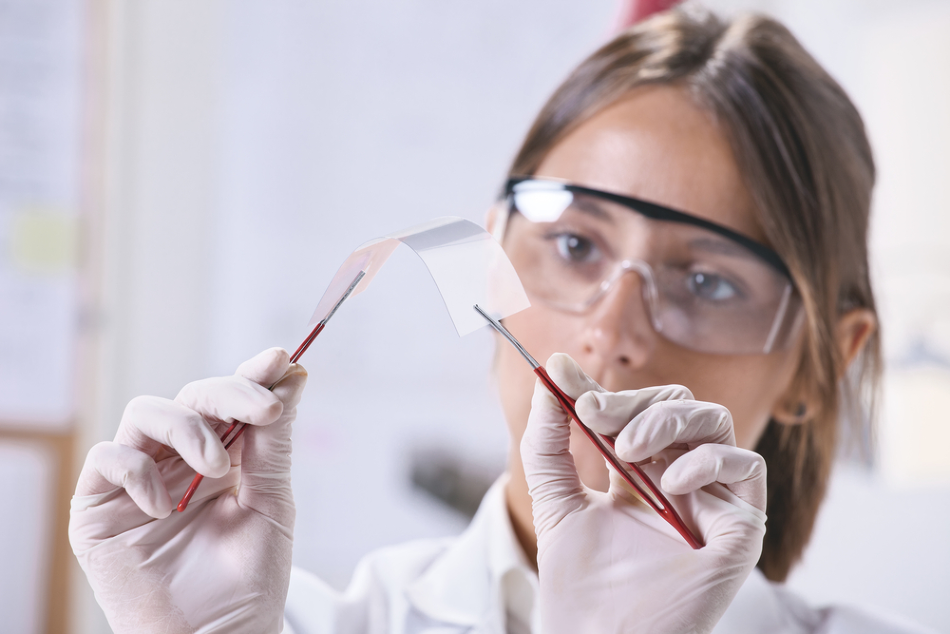
Image Credit: BONNINSTUDIO/Shutterstock.com
A large amount of scientific evidence has indicated that graphene-based products can improve the efficiency of current green energy technologies and energy storage systems that are essential to the use of intermittent energy sources such as solar and wind.
A lot of study on the green energy applications graphene materials has been on solar cells, fuel cells, batteries, supercapacitors and photoelectrochemical cells for splitting water to create hydrogen fuel.
Although a lot of effort has been dedicated to graphene-based green energy technology, it is still very much at the research stage, with just a few applications having been reported. According to researchers, new technologies for graphene production, such as 3D printing, may lead to significant breakthroughs, as they can overcome the limitations imposed by conventional graphene production methods.
Below are just a few recent innovations that use graphene materials for potential green energy applications.
Using Bacteria to Create Graphene-Nanomaterial Solar Technology
Nanotechnology includes graphene technology. Some researchers are looking to combine nanoscale crystals with graphene to produce next-generation photovoltaics.
A significant obstacle to this technology is the fact that conventional nanofabrication techniques utilize environmentally damaging chemicals and prohibitively large quantities of energy, particularly at scale. The potential environmental damage and financial cost have made existing processes nonviable, long-term solutions.
Researchers at Lehigh University in Bethlehem, Pennsylvania, recently announced the development of a novel biomineralization method for creating essential metal sulfide nanoparticles. They also produced supporting reduced graphene oxide to produce a photocatalyst that cleaves water to form hydrogen, which can be used as a fuel.
Challenges of Developing a Biomineralization Technique
The main challenge when developing a biomineralization method to create nanomaterials is establishing adequate control over essential qualities such as particle size and crystallinity. The Lehigh study team said they developed a versatile process that could both synthesize the essential nanoparticles and reduce graphene oxide to a useful form.
The study team said they were capable of fusing the two components to produce a highly efficient photocatalyst with a green process.
A Flexible Graphene Supercapacitor for High Energy Storage over Extended Timeframes
A highly efficient supercapacitor can make electric vehicles and other green technology even more viable. To develop such a supercapacitor, University College London (UCL) researchers recently announced the development of a flexible graphene supercapacitor that stores a record-high level of energy for use over an extended timeframe.
The study team said the key to their supercapacitor is the development of novel materials with high-power density, which translates to the speed a supercapacitor can charge or discharge. The team said another major element was the ability to develop materials with a high energy density, which translates to the length of use. A supercapacitor can usually only have one or the other of these qualities, but the new UCL supercapacitor provides both.
As a bonus, the new supercapacitor is capable of bending to 180 degrees without any effect on performance. Like conventional supercapacitors, the graphene-based device does not have a liquid electrolyte, which reduces the risk of explosion and expands the potential range of applications.
Adaptable Graphene Electrodes for Efficient Energy Storage
The new supercapacitor is based on a cutting-edge graphene electrode with pores that can be altered in size to hold a charge more efficiently. This versatility optimizes the energy density of the supercapacitor to 88.1 Watt-hours per liter (Wh/L). This is a level previously unseen for carbon-based supercapacitors.
Comparable fast charging technology has a relatively low energy density of 5 to 8 Wh/L. For comparison, slow-charging, long-running electric vehicle batteries typically have a 50 to 90 Wh/L energy density. However, the power density of the new graphene supercapacitor is 100 times greater than electric car batteries, at more than 10,000 Watts per liter.
Harvesting Biomass with Graphene
As researchers work to battle the factors driving climate change, algae biomass is emerging as an exciting area of study due to its ability to convert solar radiation into high-energy biomolecules.
Proponents of algae biomass have said that growing it on an industrial scale would produce compounds that can be transformed into a broad range of useful products, including biofuel. Developed on an industrial scale, algae is also capable of soaking up very large amounts of carbon dioxide. This offers the potential to significantly reduce the generation of greenhouse gas emissions.
The micro-algae cultures found in biomass have a low solid content and harvesting useful organic material with conventional methods generally calls for several dehydration steps, which can be damaging.
A team of Japanese researchers recently introduced a technique for extracting water from biomass that does not negatively affect the delicate organic compounds. In comparison with past procedures, which depended on centrifugation or mechanical squeezing, the new approach leverages solar irradiation, nanoporous graphene and porous graphene foams. The graphene-based materials contained small channels that draw water upwards and away from the biomass.
This novel material also safeguards the biomass from getting too hot while capturing the sun's energy.
References and Further Reading
Lehigh University (2019) Promising new solar-powered path to hydrogen fuel production. [Online] ScienceDaily. Available at: https://www.sciencedaily.com/releases/2019/08/190801142548.htm (Accessed on 20 March 2020).
University College London (2020) Fast-charging, long-running, bendy energy storage breakthrough. [Online] Science Daily. Available at: https://www.sciencedaily.com/releases/2020/02/200217112732.htm (Accessed on 20 March 2020)
University of Tsukuba (2019) Left out to dry: A more efficient way to harvest algae biomass. Available at: https://www.sciencedaily.com/releases/2019/07/190709110212.htm (Accessed on 20 March 2020).
Disclaimer: The views expressed here are those of the author expressed in their private capacity and do not necessarily represent the views of AZoM.com Limited T/A AZoNetwork the owner and operator of this website. This disclaimer forms part of the Terms and conditions of use of this website.